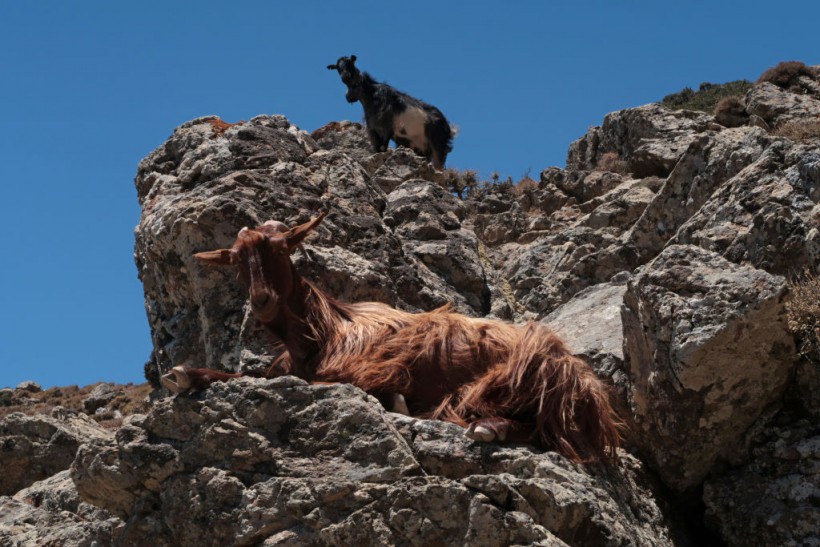Snow is usually associated with winter, but for some animals, snow is a precious resource that they need even in the summer.
One of these animals is the mountain goat, a remarkable creature that can climb steep cliffs and survive harsh conditions. But what does snow have to do with mountain goats in the summer?
A new study has revealed that mountain goats seek out snow patches not only to cool off, but also to shake off biting insects that can harm them.
The Problem of Biting Insects
 (Photo : Sean Gallup/Getty Images)
(Photo : Sean Gallup/Getty Images)

Mountain goats are amazing animals that can live in some of the most rugged and remote habitats in the world.
They are well adapted to cold and snowy conditions, but they face a challenge in the summer: biting insects.
Biting insects, such as flies, mosquitoes, and ticks, can be a nuisance and a threat for many animals. They can cause irritation, inflammation, infection, blood loss, and disease transmission.
For mountain goats, biting insects can also affect their behavior, physiology, and survival.
Mountain goats have thick fur that protects them from the cold, but also makes them vulnerable to overheating and insect attacks.
To cope with the heat and the insects, mountain goats need to find ways to cool off and avoid being bitten. One of the ways they do that is by seeking out snow patches.
The Benefits of Snow Patches
Snow patches are areas of snow that persist through the summer, usually at high elevations or in shaded locations.
Snow patches offer many benefits for mountain goats and other cold-adapted species, such as:
Corridors for travel
Snow patches can provide easier and safer routes for mountain goats to move across the landscape, avoiding steep and rocky terrain.
Sources of drinking water: Snow patches can supply fresh and clean water for mountain goats, especially in dry and arid regions.
Zones for cooling off
Snow patches can help mountain goats regulate their body temperature, by allowing them to lie down on the snow or lick the snow to lower their heat stress.
Places to play
Snow patches can also provide opportunities for mountain goats to have fun, by sliding, rolling, or jumping on the snow.
Relief from biting insects
But perhaps the most important benefit of snow patches for mountain goats is that they offer relief from biting insects.
A recent study by Forest Hayes and Joel Berger, published in PNAS Nexus1, found that mountain goats seek out snow patches not only to cool off, but also to escape the torment of biting insects.
The researchers studied two populations of mountain goats, one in Glacier National Park, Montana, and another 1,000 km south, in Colorado.
They observed the goats using telephoto lenses and recorded their respiration rate and ear-flicking frequency, as indicators of heat stress and insect disturbance, respectively.
They found that ear flicking was strongly correlated with the presence of snow patches, meaning that mountain goats were less bothered by insects when they were on or near snow.
Respiration rate, on the other hand, was not affected by snow patches, suggesting that heat stress was not a major factor for mountain goats.
The researchers concluded that snow patches provide a valuable refuge for mountain goats from biting insects, which can have negative impacts on their health and fitness.
They also warned that the loss of snow patches due to climate change may pose a serious threat for mountain goats and other species that depend on them.
Also Read: Mountain Goat Mauls Grizzly Bear to Death in Canadian National Park
The Future of Snow Patches and Mountain Goats
Snow patches are disappearing rapidly in many parts of the world, as a result of global warming and human activities.
For example, Glacier National Park, where the study was conducted, has lost 85% of its glaciers since 1850, and is expected to lose all of them by 2030.
This means that mountain goats and other animals will have less access to snow patches in the future, and will have to cope with more heat and more insects.
This could have serious consequences for their survival and reproduction, as well as their distribution and behavior.
The researchers suggested that conservation efforts should consider the importance of snow patches for mountain goats and other species, and try to protect and restore them where possible.
They also recommended further research on the effects of biting insects on mountain goats and other animals and the potential ways to mitigate them.
Snow patches are more than just frozen water. They are vital resources for mountain goats and other wildlife, that help them survive the summer.
By understanding and preserving snow patches, we can help mountain goats and other species thrive in a changing world.
Related article: America's Mountain Goats Are Now Being Threatened by Melting Ice and Snow
© 2024 NatureWorldNews.com All rights reserved. Do not reproduce without permission.




![Roundworms with Short Memories 'Stop Forgetting' When Frozen or Given Lithium [Study]](https://1471793142.rsc.cdn77.org/data/thumbs/full/70295/280/157/50/40/roundworms-with-short-memories-stop-forgetting-when-frozen-or-given-lithium-study.jpg)
